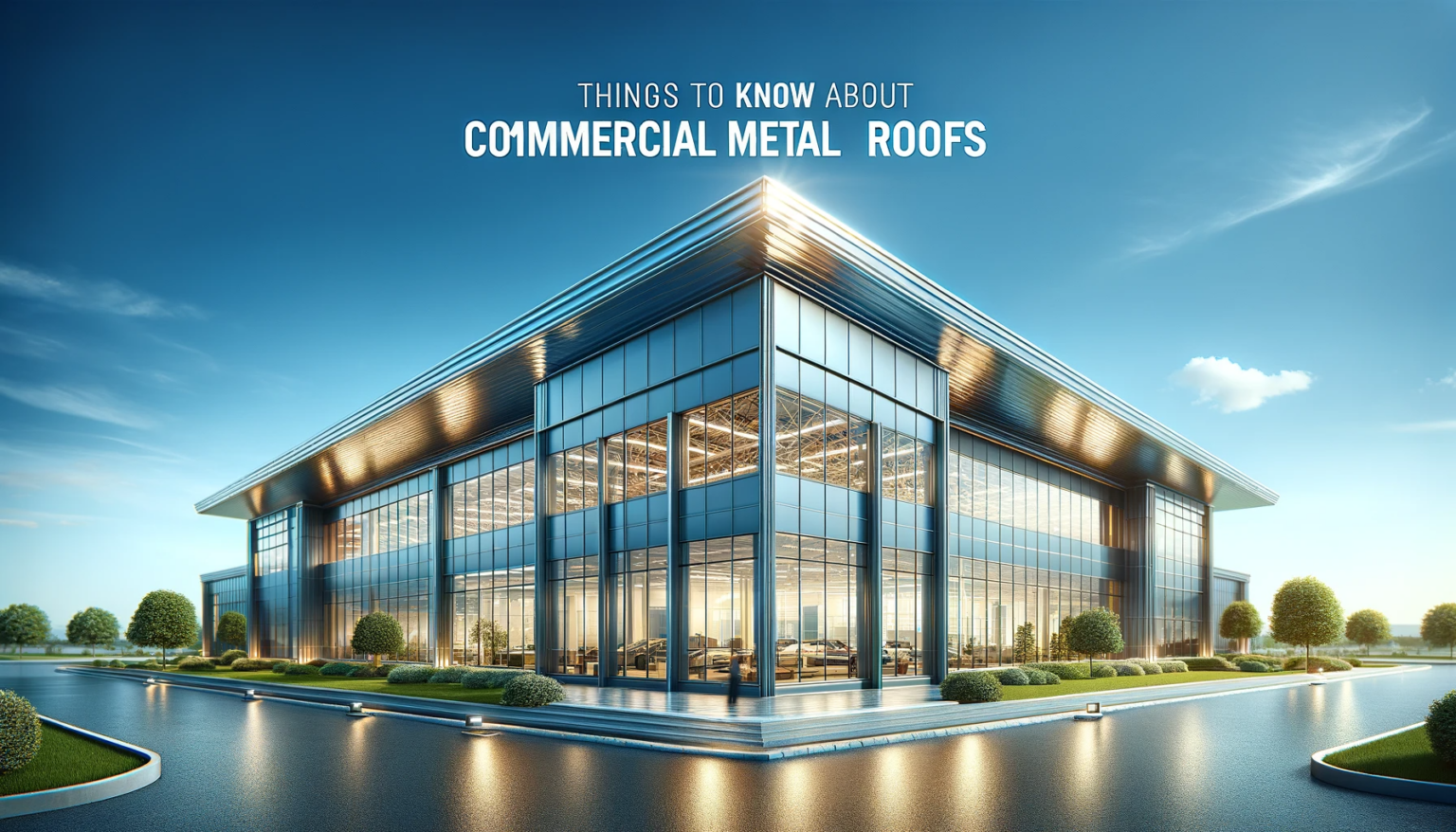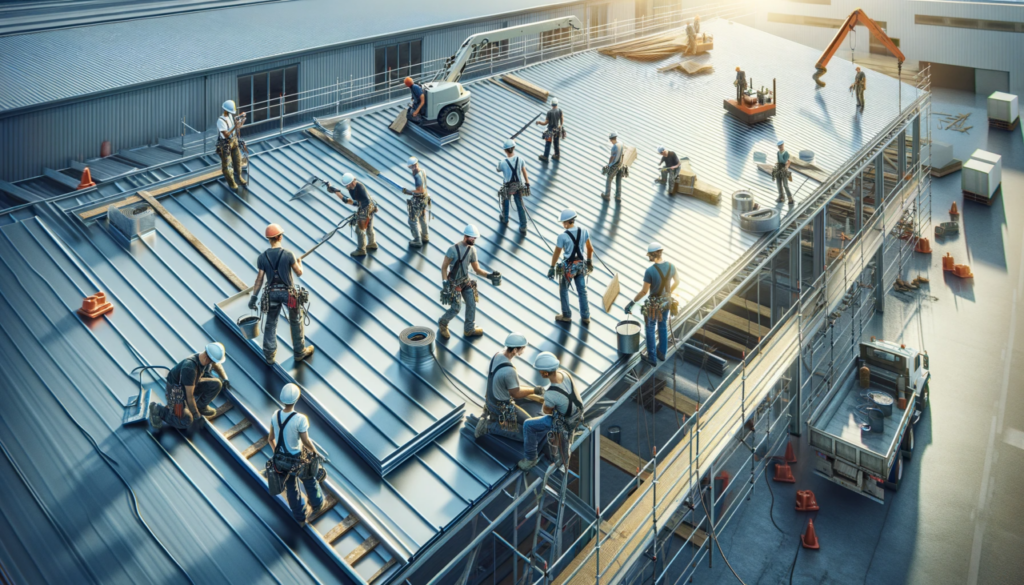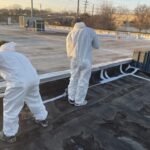
Things to Know About Commercial Metal Roofs
Who doesn’t want durable, efficient, and sustainable roofing option for your commercial property. You’ll arrive at work feeling safe and you’ll leaving knowing that you put in a good day’s work with one less thing to worry about.
Enter metal roofing.
Metal roofing is gaining popularity among business owners and managers around the globe, no matter what the temperate zone is, as it offers many advantages over traditional roofing materials.
But what exactly is metal roofing, and what are the benefits and challenges of installing it?
Let’s talk.
- The rise of commercial metal roofing
- Types of metal roofs
- Advantages of metal roofing
- Installation considerations
- Maintenance and care
- Cost and ROI
The Rise of Commercial Metal Roofing
Metal roofing isn’t a new concept. It’s been used for centuries in various forms and applications, such as copper domes, tin shingles, and corrugated panels. However, in recent years, metal roofing has seen a resurgence in popularity, especially in commercial settings for building.
By the numbers:
According to the Metal Roofing Alliance (MRA), the market share of metal roofing in the commercial sector increased from 12% in 2015 to 14% in 2019. This means that more and more business owners and managers are choosing metal roofing for their buildings, such as warehouses, factories, offices, schools, hospitals, and retail stores.
Types of Metal Roofs
Let’s look at the different types of metal roofs that are available for commercial use. Metal roofs can be classified into two main categories: aluminum and steel. Each category has its own pros and cons.
Aluminum vs Steel
Aluminum and steel are the most common materials used in commercial metal roofing. They have some similarities and differences in terms of durability, performance, cost, and appearance.
Aluminum is a lightweight and corrosion-resistant metal that can withstand harsh weather conditions, such as saltwater exposure, acid rain, or hail. It is also easy to form and install, and has a high reflectivity that reduces heat absorption. Aluminum roofs typically last between 30 to 50 years.
Steel is a strong and fire-resistant metal that can support heavy loads and resist impact. It is also easy to coat or paint to enhance its appearance and performance. Steel roofs typically last between 40 to 60 years.
However, both aluminum and steel have some drawbacks as well. Aluminum is more expensive than steel, and can dent or scratch easily. Steel is heavier than aluminum, and can rust or corrode if not properly coated or maintained.
So if you’re choosing between aluminum and steel for your commercial metal roof, there are some things to consider:
- The climate of your location: If you are located in a coastal or humid area, you may want to choose aluminum for its corrosion resistance. If you are located in an inland or dry area, you may want to choose steel for its strength and fire resistance.
- The type of your building: If you have a lightweight or low-slope building, you may want to choose aluminum for its lightness and flexibility. If you have a heavy or steep-slope building, you may want to choose steel for its support and durability.
- The budget of your project: If you have a high budget or a long-term perspective, you may want to choose aluminum for its longevity and efficiency. If you have a low budget or a short-term perspective, you may want to choose steel for its affordability and availability.
Corrugated Panels and Standing Seams
Apart from the material, another factor that affects the type of your commercial metal roof is the style. There are two main styles of metal roofs: corrugated panels and standing seams.
Corrugated panels are metal sheets that have a wavy or ribbed pattern that adds strength and rigidity. They are fastened with exposed screws or nails to the roof deck or substrate. Corrugated panels are cheaper and easier to install than standing seams, but they also have more seams and fasteners that can leak or corrode over time.
Standing seams are metal sheets that have vertical ridges that interlock with each other to form a continuous surface. They are fastened with concealed clips or brackets to the roof deck or substrate. Standing seams are more expensive and difficult to install than corrugated panels, but they also have fewer seams and fasteners that can improve the appearance and performance of the roof.
So if you’re choosing between corrugated panels and standing seams for your commercial metal roof, you need to consider factors such as:
- The slope of your roof: If you have a low-slope or flat roof, you may want to choose corrugated panels for their water-shedding ability. If you have a steep-slope or pitched roof, you may want to choose standing seams for their water-tightness and aesthetics.
- The design of your building: If you have a simple or rustic building, you may want to choose corrugated panels for their traditional and industrial look. If you have a modern or sophisticated building, you may want to choose standing seams for their sleek and contemporary look.
- The maintenance of your roof: If you have a low-maintenance or high-durability roof, you may want to choose standing seams for their longevity and reliability. If you have a high-maintenance or low-durability roof, you may want to choose corrugated panels for their ease and affordability.
Advantages of Metal Roofing
First, we’re going to lead with team Metal Roofing. Metal roofing has many benefits that can make it an attractive option for your commercial property, such as:
Longevity
By the Numbers:
One of the main advantages of metal roofing is its longevity. Metal roofs can last between 30 to 60 years, depending on the material and style. This is much longer than other roofing materials, such as asphalt shingles (15 to 25 years), wood shingles (20 to 30 years), or tile roofs (25 to 50 years).
Metal roofs can also withstand harsh weather conditions, such as high winds, heavy rains, snow, hail, fire, or UV rays. Metal roofs are also resistant to pests, rot, mold, and corrosion. Metal roofs can also be coated or painted to prevent fading or rusting.
Energy Efficiency
Another advantage of metal roofing is its energy efficiency. A huge trend not just for consumers, but also for businesses these days. Metal roofs can save energy and reduce costs by reflecting solar heat and preventing heat loss. According to the MRA,metal roofs can lower your cooling costs by up to 40% in summer and your heating costs by up to 15% in winter.
Metal roofs can also improve your building’s insulation and ventilation by creating an air gap between the metal panels and the roof deck or substrate. This can prevent heat buildup, moisture accumulation, and ice dams on your roof.
Metal roofs can also qualify for federal, state, or local tax credits or incentives for using energy-efficient or renewable energy roofing materials or systems. For example, if you install a cool roof or a solar roof on your commercial property, you may be eligible for a tax credit of up to 30% of the cost of installation.
Environmental Impact
Another advantage of metal roofing is its environmental impact. Metal roofing is one of the most sustainable and eco-friendly roofing options available. Metal roofing has several environmental benefits, such as:
- Recyclability: Metal roofing is made of recycled materials and can be recycled again at the end of its life. According to the MRA, metal roofing contains up to 95% recycled content and can be recycled indefinitely without losing its quality or value.
- Durability: Metal roofing reduces waste and pollution by lasting longer than other roofing materials and requiring less maintenance and repair. According to the MRA, metal roofing saves up to 20 billion pounds of asphalt shingle waste from landfills every year.
- Compatibility: Metal roofing is compatible with other green technologies and practices, such as solar panels, green roofs, rainwater harvesting, or daylighting. Metal roofing can also enhance the performance and efficiency of these technologies and practices by providing support, protection, or reflectivity.

Installation Considerations
So we’ve heard the good parts. All the advantages. However, metal roofing also has some challenges that you need to consider.
Proper Installation
One of the most important installation considerations for metal roofing is proper installation. Proper installation can ensure that your metal roof meets the manufacturer’s specifications and warranty requirements. It can also ensure that your metal roof performs well and lasts long.
Proper installation involves following the best practices and guidelines for each type of metal roof material and style. For example, proper installation for aluminum roofs involves using aluminum fasteners and accessories to prevent galvanic corrosion. Proper installation for steel roofs involves using galvanized or stainless steel fasteners and accessories to prevent rusting. Do it wrong, you’re losing out on all of the benefits of the initial investment.
Proper installation also involves hiring a professional and certified commercial roofer who has the knowledge and experience to handle any type of metal roofing project. (Enter us). A professional commercial roofer can also provide you with expert advice on the best metal roofing material and design for your needs and budget.
Keeping the Old Roof
Keeping the old roof involves installing metal roofing over the existing roof, rather than removing it and installing a new one. There’s a common misconception that you can’t have both.
Some of the benefits of keeping the old roof include:
- Saving time and money: Keeping the old roof can save you time and money by reducing the labor and disposal costs of removing the old roof. It can also save you time and money by avoiding any disruptions or delays in your business operations during the installation process.
- Adding insulation and protection: You’re getting double the benefits.Keeping the old roof can add insulation and protection to your metal roof by creating an air gap between the metal panels and the old roof. This can improve your building’s energy efficiency and prevent water damage.
As with any home improvement update, you must think of both sides of the coin, so to speak. Some of the drawbacks of keeping the old roof include:
- Adding weight and stress: Keeping the old roof can add weight and stress to your metal roof by increasing the load on your roof deck or substrate. This can affect your building’s structural integrity and safety, especially if your building is old or weak.
- Hiding problems and defects: Keeping the old roof can hide problems and defects that may exist in your old roof, such as leaks, rot, mold, or corrosion. This can compromise your metal roof’s performance and durability, and lead to more extensive and costly damages in the future.
So, now it’s decision time. Take the time, have the conversations, and think about the below:
- The condition of your old roof: If your old roof is in good condition and has no major issues or defects, you may want to keep it for its benefits. If your old roof is in poor condition and has many issues or defects, you may want to remove it for its drawbacks.
- The type of your old roof: If your old roof is made of a compatible material and has a similar slope or style as your metal roof, you may want to keep it for its ease and affordability. If your old roof is made of an incompatible material or has a different slope or style as your metal roof, you may want to remove it for its difficulty and expense.
- The code of your area: If your area has a code or regulation that allows or requires you to keep or remove the old roof, you need to follow it for compliance and safety.
Maintenance and Care
As we have discussed, metal roofing is one of the most durable and long-lasting roofing options available. You’ve got a lot of options out there in the market, but metal roofing can be an underdog winner for most.
However, metal roofing still requires some maintenance and care to keep it in good shape and extend its life. Some of the maintenance and care tasks that you need to perform on your metal roof include:
Regular Check-ups
One of the maintenance tasks that you need to perform on your metal roof is regular check-ups. Check-ups involve inspecting your metal roof at least twice a year,preferably in spring and fall. You should also inspect your metal roof after any severe weather events, such as storms, hail, or snow.
During a check-up, you should look for signs of damage or deterioration on your metal roof surface, such as dents, scratches, cracks, holes, rust, or fading. You should also check your flashing, vents, skylights, chimneys, pipes, and other penetrations for any gaps, leaks, or corrosion. You should also check your drainage system,such as gutters, downspouts, scuppers, and drains for any clogs, leaks, or damage.
If you find any problems during your check-up, you should document them with photos and notes, and contact a professional commercial roofer as soon as possible. A commercial roofer can provide you with a detailed assessment of your metal roof’s condition and recommend the best course of action.
What to Look For
What to look for involves identifying issues that may require attention or intervention on your metal roof. Some of the issues that you need to look for on your metal roof include:
- Noise: Noise is a common issue that may occur on metal roofs due to thermal expansion and contraction. There are the soothing noises in the morning and evening, but these are a little bit different. Noise can be annoying or distracting for you and your customers or employees. Noise can also indicate loose or faulty fasteners or components that may affect your metal roof’s stability or performance.
- Leaks: Leaks are another common issue that may occur on metal roofs due to improper installation, inadequate flashing, insufficient slope, or damaged material. Leaks can cause water damage, mold growth, electrical hazards, or health issues. Leaks can also affect your metal roof’s appearance, value, and reputation.
- Corrosion: Corrosion is another common issue that may occur on metal roofs due to exposure to moisture, saltwater, acid rain, or chemicals. Corrosion can damage your metal roof’s material and coating, and compromise its integrity and performance. Corrosion can also affect your metal roof’s appearance, value, and reputation.
If you notice any of these issues on your metal roof, you should not ignore or delay them. You should contact a professional commercial roofer as soon as possible to resolve them for recommendations on maintenance and care.
Cost and ROI
As with all of the best elements of a home, there is a cost associated. And generally, it’s worth it. Metal roofing also has a higher initial cost than other roofing materials. So let’s think through that and the ROI over a longer period of time in a property that you’ve already invested in – emotionally and financially.
Initial Costs
The initial cost of metal roofing depends on several factors, such as the material, style, size, design, and installation of your metal roof. According to Home Advisor, the average cost of installing a metal roof on a commercial building ranges from $7 to $13 per square foot. This means that for a typical 10,000 square foot commercial building, the initial cost of metal roofing can range from $70,000 to $130,000. While this is a rough estimate, we’re lucky to live in a day and age with all sorts of calculators and resources – both online and in-person.
ROI
The ROI of metal roofing depends on several factors, such as the lifespan, energy efficiency, environmental impact, and maintenance of your metal roof. According to Roofing Calculator, the average ROI of metal roofing for a commercial building ranges from 85% to 95%. This means that for a typical 10,000 square foot commercial building with a metal roof that costs $100,000 to install, the ROI can range from $85,000 to $95,000.
The same advice goes for the above as far as having a second opinion. And we’re happy to help with that.
Things to Know About Commercial Metal Roofs
Here are the cliffnotes about Metal Roofs:
The good –
- Longevity: Commercial metal roofs can last between 30 to 60 years, depending on the material and style.
- Energy Efficiency: Commercial metal roofs can save energy and reduce costs by reflecting solar heat and preventing heat loss.
- Environmental Impact: Commercial metal roofs are sustainable and eco-friendly by being recyclable, durable, and compatible with other green technologies and practices.
The challenging –
- Proper Installation: Commercial metal roofs require proper installation by a professional and certified commercial roofer to ensure their quality and performance.
- Keeping the Old Roof: Commercial metal roofs may or may not be installed over the existing roof, depending on the condition, type, and code of your old roof.
- Maintenance and Care: Commercial metal roofs require regular check-ups and timely repairs to keep them in good shape and extend their life.
By knowing these things about commercial metal roofs, you can figure out what makes sense for you. Reach out with any questions and we’ll start the conversation to make your home as safe and smart as possible.


 Previous Post
Previous Post Next Post
Next Post